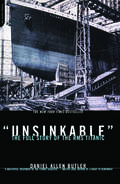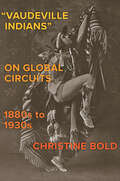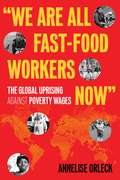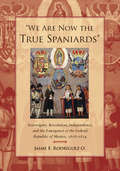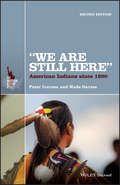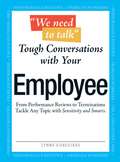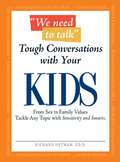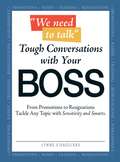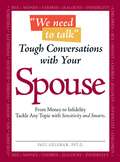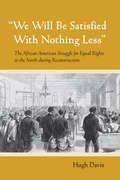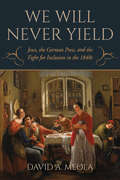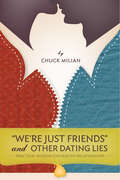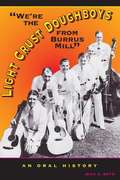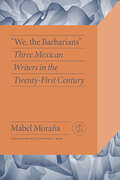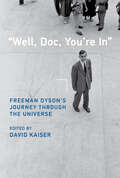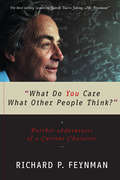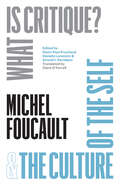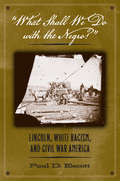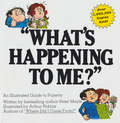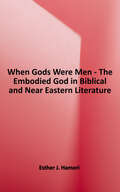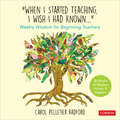- Table View
- List View
"Unsinkable": The Full Story of RMS Titanic
by Daniel Allen ButlerThis passionate yet balanced narrative explores every facet of the Titanic's history, including her spectacular conception in an Irish shipyard and the ambitious modern-day attempts to salvage her. The familiar story of the RMS Titanic-from her encounter with an iceberg to her demise some three hours later, taking with her more than fifteen hundred people-still looms large in the popular imagination, and in Daniel Butler's as well. He studied the Titanic's history for thirty years, intensively compiling facts about the disaster and the players involved (from Captain Smith and his crew to the ill-fated third-class passengers). He even made the startling discovery of a nearby ship that ignored the Titanic's distress call because the shipmates were afraid to awaken their captain. Drawn from primary sources and period accounts, this new narrative puts the disaster into historical context and serves as an essential resource for scholars of Titanic lore.
"Vaudeville Indians" on Global Circuits, 1880s-1930s (The Henry Roe Cloud Series on American Indians and Modernity)
by Christine BoldUncovering hidden histories of Indigenous performers in vaudeville and in the creation of western modernity and popular culture Drawing from little-known archives, Christine Bold brings to light forgotten histories of Indigenous performers in vaudeville and, by extension, popular culture and modernity. Vaudeville was both a forerunner of modern mass entertainment and a rich site of popular Indigenous performance and notions of Indianness at the turn of the twentieth century. Tracing the stories of artists Native to Turtle Island (North America) performing across the continent and around the world, Bold illustrates a network of more than 300 Indigenous and Indigenous-identifying entertainers, from Will Rogers to Go-won-go Mohawk to Princess Chinquilla, who upend vaudeville&’s received history. These fascinating stories cumulatively reveal vaudeville as a space in which the making of western modernity both denied and relied on living Indigenous presence, and in which Indigenous artists negotiated agency and stereotypes through vaudeville performance.
"Virtu," Virtue, and Success: Translating Your Moral Code into Management Practice
by Joseph L. Badaracco Jr.Managers are often faced with tough ethical decisions that affect not only themselves, but define their organization's role in society and its relations with stakeholders. This chapter draws practical advice for managers facing difficult problems from Machiavelli's and Aristotle's theories on moral code, virtue, and success. This chapter is excerpted from "Defining Moments: When Managers Must Choose between Right and Right."
"Watch Out for the Foreign Guests!"
by Orville SchellThis vivid, prophetic book on China's magnetic attraction to the West is the perfect introduction to China in the eighties.
"We Are All Fast-Food Workers Now": The Global Uprising Against Poverty Wages
by Annelise OrleckThe story of low-wage workers rising up around the world to demand respect and a living wage.Tracing a new labor movement sparked and sustained by low-wage workers from across the globe, "We Are All Fast-Food Workers Now" is an urgent, illuminating look at globalization as seen through the eyes of workers-activists: small farmers, fast-food servers, retail workers, hotel housekeepers, home-healthcare aides, airport workers, and adjunct professors who are fighting for respect, safety, and a living wage. With original photographs by Liz Cooke and drawing on interviews with activists in many US cities and countries around the world, including Bangladesh, Cambodia, Mexico, South Africa, and the Philippines, it features stories of resistance and rebellion, as well as reflections on hope and change as it rises from the bottom up.
"We Are Now the True Spaniards": Sovereignty, Revolution, Independence, and the Emergence of the Federal Republic of Mexico, 1808-1824
by Jaime E. Rodríguez O.This book is a radical reinterpretation of the process that led to Mexican independence in 1821—one that emphasizes Mexico's continuity with Spanish political culture. During its final decades under Spanish rule, New Spain was the most populous, richest, and most developed part of the worldwide Spanish Monarchy, and most novohispanos (people of New Spain) believed that their religious, social, economic, and political ties to the Monarchy made union preferable to separation. Neither the American nor the French Revolution convinced the novohispanos to sever ties with the Spanish Monarchy; nor did the Hidalgo Revolt of September 1810 and subsequent insurgencies cause Mexican independence. It was Napoleon's invasion of Spain in 1808 that led to the Hispanic Constitution of 1812. When the government in Spain rejected those new constituted arrangements, Mexico declared independence. The Mexican Constitution of 1824 affirms both the new state's independence and its continuance of Spanish political culture.
"We Are Still Here": American Indians Since 1890 (The American History Series #51)
by Peter Iverson Wade DaviesIn addition to revisions and updates, the second edition of “We Are Still Here” features new material, seeing this well-loved American History Series volume maintain its treatment of American Indians in the 20th century while extending its coverage into the opening decades of the 21st century. Provides student and general readers concise and engaging coverage of contemporary history of American Indians contributed by top scholars and instructors in the field Represents an ideal supplement to any U.S. or Native American survey text Includes a completely up-to-date synthesis of the most current literature in the field Features a comprehensive Bibliographical Essay that serves to aid student research and writing Covers American Indian history from 1890 through 2013
"We Need To Talk" - Tough Conversations With Your Employee
by Lynne EisaguirreWhen it comes to talking to an employee about a touchy topic, managers often find themselves at a loss for the right words. Before the talk, they are stuck wondering, "Where do I begin?" "What do I say?" and "How will he/she react?" Answering employers' most pressing questions, this go-to guide shows people what to say and how to say it. It features practical and precise advice for specific problem topics and realistic scripts that help dictate what should and should not be said. Not overly academic, this practical primer advises different-level managers, in all industries, how to have those conversations that they dread.
"We Need To Talk" - Tough Conversations With Your Kids
by Richard HeymanSex. Drugs. Divorce. When it's time for "the talk," many parents panic. They need a simple guide to help them - and now they have it. In this book, parenting expert Dr. Richard Heyman teaches parents how to approach kids with honesty and understanding. He answers questions like "How do I bring it up?", "What should I say?", and "How will he/she/they react?" It features practical and precise advice for specific problem topics and realistic scripts that help dictate what should and should not be said. Complete with realistic sample scripts, this go-to guide helps parents tackle tough topics with conviction and composure.
"We Need to Talk" - Tough Conversations With Your Boss
by Lynne EisaguirreAsking a boss about more responsibility, an inappropriate coworker, or for some extra help can be scary! Employees don't want to step on anyone's toes or cross any boundaries, but they need answers! Tackling your most pressing questions and offering advice on what to say and how to say it, this book is every stressed employee's dream come true. This step-by-step guide covers workplace dialogue dilemmas like leave requests, disability discussions, performance issues, and promotion requests.It features:practical and precise advice for specific problem topicspoints of quick reference at a great pricerealistic scripts that help dictate what should and should not be said.
"We Need to Talk" - Tough Conversations With Your Spouse
by Paul ColemanCouples need a straightforward, no-nonsense guide that teaches them how to initiate a difficult discussion with their spouse with composure, confidence, and a plan. From good opening statements to final remarks, relationship expert Paul Coleman, Psy.D., offers realistic scripts that cover topics like physical and emotional intimacy, mistrust and infidelity, unhappiness, and forgiveness. It features practical and precise advice for specific problem topics and realistic scripts that help dictate what should and should not be said.Perfect for couples who are struggling to communicate, this book is an honest guide to bettering a marriage.
"We Never Had a Language for It": Engaging the Emotional Life of the Organization--Assessing a Group's Immunity to Change
by Lisa Laskow Lahey Robert KeganHow do you become a learning organization? As a leader, you cannot grow the organization's ability to achieve its goals alone. Identifying goals as a team and bringing professional development issues to the forefront supports learning on a personal and organizational level simultaneously. This chapter tells the stories of two leadership teams that took on the challenge of identifying roadblocks to change in their organizations and adopted an inclusive approach to leadership development that aligns personal and organizational learning. This chapter is excerpted from "Immunity to Change: How to Overcome It and Unlock the Potential In Yourself and Your Organization."
"We Will Be Satisfied With Nothing Less": The African American Struggle for Equal Rights in the North during Reconstruction
by Hugh DavisHistorians have focused almost entirely on the attempt by southern African Americans to attain equal rights during Reconstruction. However, the northern states also witnessed a significant period of struggle during these years. Northern blacks vigorously protested laws establishing inequality in education, public accommodations, and political life and challenged the Republican Party to live up to its stated ideals. In "We Will Be Satisfied With Nothing Less," Hugh Davis concentrates on the two issues that African Americans in the North considered most essential: black male suffrage rights and equal access to the public schools. Davis connects the local and the national; he joins the specifics of campaigns in places such as Cincinnati, Detroit, and San Francisco with the work of the National Equal Rights League and its successor, the National Executive Committee of Colored Persons. The narrative moves forward from their launching of the equal rights movement in 1864 to the "end" of Reconstruction in the North two decades later. The struggle to gain male suffrage rights was the centerpiece of the movement’s agenda in the 1860s, while the school issue remained a major objective throughout the period. Following the ratification of the Fifteenth Amendment in 1870, northern blacks devoted considerable attention to assessing their place within the Republican Party and determining how they could most effectively employ the franchise to protect the rights of all citizens.
"We Will Never Yield": Jews, the German Press, and the Fight for Inclusion in the 1840s (German Jewish Cultures)
by David A. MeolaHow did German Jews present their claims for equality to everyday Germans in the first half of the nineteenth century? We Will Never Yield offers the first English-language study of the role of the German press in the fight for Jewish agency and participation during the 1840s. David Meola explores how the German press became a key venue for public debates over Jewish emancipation; religious, educational, and occupational reforms; and the role of Jews in German civil society, even against a background of escalating violence against the Jews in Germany. We Will Never Yield sheds light on the struggle for equality by German Jews in the 1840s and demonstrates the value of this type of archival source of Jewish voices that has been previously underappreciated by historians of Jewish history.
"We're Just Friends" and Other Dating Lies
by Chuck MilianSafely Navigating the Dating MinefieldHurt feelings, unmet expectations, dashed hopes, misplaced trust - these are just some of the potential time bombs that explode in dating relationships leaving a trail of broken hearts. Does it have to be this way? Do you have to stop dating to protect yourself and others from deep hurt?As a pastor of a large congregation and former singles pastor, author Chuck Milian has seen firsthand the broken relationships that occur when men and women don't move with proactive care in and through their dating relationships. With pastoral wisdom and insight, Milian educates readers about defining expectations before they start dating, and he outlines a specific five-step dating plan that will help limit relational damage as they look for someone to share their lives with. The author encourages, challenges, and instructs believers in this comprehensive how-to-date handbook. He gives practical advice on wisely forming relationships with the opposite sex while still having fun, avoiding unnecessary hurts, making lifelong friends, and knowing "where they are" each step of the way. Filled with personal reflections and insights, singles will take a look back at their past relational mishaps and move forward into a biblically healthy and romantically fulfilling relationship as God intended it to be. This book remedies and reduces the casualties of the current dating minefield where hearts get broken daily and sometimes never recover.
"We're the Light Crust Doughboys from Burrus Mill": An Oral History
by Boyd Jean A.The Light Crust Doughboys are one of the most long-lived and musically versatile bands in America. Formed in the early 1930s under the sponsorship of Burrus Mill and Elevator Company of Fort Worth, Texas, with Bob Wills and Milton Brown (the originator of western swing) at the musical helm and future Texas governor W. Lee "Pappy" O'Daniel as band manager and emcee, the Doughboys are still going strong in the twenty-first century. Arguably the quintessential Texas band, the Doughboys have performed all the varieties of music that Texans love, including folk and fiddle tunes, cowboy songs, gospel and hymns, commercial country songs and popular ballads, honky-tonk, ragtime and blues, western swing and jazz, minstrel songs, movie hits, and rock 'n' roll.
"We, the Barbarians": Three Mexican Writers in the Twenty-First Century (Critical Mexican Studies)
by Mabel Moraña&“We, the Barbarians&” embarks on a careful and exhaustive reading of three of the most prominent authors in the latest wave of Mexican fiction: Yuri Herrera, Fernanda Melchor, and Valeria Luiselli. Originally published in Mexico in 2021, this work is divided into three parts, one for each author&’s narrative production. The book analyzes all of the literary works published by Herrera, Melchor, and Luiselli from the beginning of their writing careers until 2021, allowing for a diachronic interpretation of their respective narrative projects as well as for comparative approaches to their aesthetic and ideological contours. Characterized by the fragmentation of civil society and the decomposition of the myths that accompanied the consolidation of the modern nation, Mexican visual and literary arts have explored a myriad of representational avenues to approach the phenomena of violence, institutional decay, and political instability. The critical and theoretical approaches in &“We, the Barbarians&” explore a variety of alternative symbolic representations of topics such as nationalism, community, and affect in times impacted by systemic violence, precariousness, and radical inequality. Moraña perceives the negotiations between regional/local imaginaries and global scenarios characterized by the devaluation and resignification of life, both at individual and collective levels. Though it uses three authors as its focus, this book seeks to more broadly theorize the question of the relationship between literature and the social in the twenty-first century.
"Well, Doc, You're In": Freeman Dyson’s Journey through the Universe
by Edited by David KaiserThe life and work of Freeman Dyson—renowned scientist, visionary, and iconoclast—and his particular way of thinking about deep questions.Freeman Dyson (1923–2020)—renowned scientist, visionary, and iconoclast—helped invent modern physics. Not bound by disciplinary divisions, he went on to explore foundational topics in mathematics, astrophysics, and the origin of life. General readers were introduced to Dyson&’s roving mind and heterodox approach in his 1979 book Disturbing the Universe, a poignant autobiographical reflection on life and science. &“Well, Doc, You&’re In&” (the title quotes Richard Feynman&’s remark to Dyson at a physics conference) offers a fresh examination of Dyson&’s life and work, exploring his particular way of thinking about deep questions that range from the nature of matter to the ultimate fate of the universe. The chapters—written by leading scientists, historians, and science journalists, including some of Dyson&’s colleagues—trace Dyson&’s formative years, his budding interests and curiosities, and his wide-ranging work across the natural sciences, technology, and public policy. They describe Dyson&’s innovations at the intersection of quantum theory and relativity, his novel nuclear reactor design (and his never-realized idea of a spacecraft powered by nuclear weapons), his years at the Institute for Advanced Study, and his foray into cosmology. In the coda, Dyson&’s daughter Esther reflects on growing up in the Dyson household. &“Well, Doc, You&’re In&” assesses Dyson&’s successes, blind spots, and influence, assembling a portrait of a scientist&’s outsized legacy. ContributorsJeremy Bernstein, Robbert Dijkgraaf, Esther Dyson, George Dyson, Ann Finkbeiner, Amanda Gefter, Ashutosh Jogalekar, David Kaiser, Caleb Scharf, William Thomas
"What Do You Care What Other People Think?": Further Adventures of a Curious Character
by Ralph Leighton Richard P. FeynmanThe New York Times best-selling sequel to "Surely You're Joking, Mr. Feynman!" One of the greatest physicists of the twentieth century, Richard Feynman possessed an unquenchable thirst for adventure and an unparalleled ability to tell the stories of his life. "What Do You Care What Other People Think?" is Feynman's last literary legacy, prepared with his friend and fellow drummer, Ralph Leighton. Among its many tales--some funny, others intensely moving--we meet Feynman's first wife, Arlene, who taught him of love's irreducible mystery as she lay dying in a hospital bed while he worked nearby on the atomic bomb at Los Alamos. We are also given a fascinating narrative of the investigation of the space shuttle Challenger's explosion in 1986, and we relive the moment when Feynman revealed the disaster's cause by an elegant experiment: dropping a ring of rubber into a glass of cold water and pulling it out, misshapen.
"What Is Critique?" and "The Culture of the Self" (The Chicago Foucault Project)
by Michel FoucaultNewly published lectures by Foucault on critique, Enlightenment, and the care of the self. On May 27, 1978, Michel Foucault gave a lecture to the French Society of Philosophy where he redefined his entire philosophical project in light of Immanuel Kant’s 1784 text “What Is Enlightenment?” Foucault strikingly characterizes critique as the political and moral attitude consisting in the “art of not being governed like this,” one that performs the function of destabilizing power relations and creating the space for a new formation of the self within the “politics of truth.” This volume presents the first critical edition of this crucial lecture alongside a previously unpublished lecture about the culture of the self and three public debates with Foucault at the University of California, Berkeley, in April 1983. There, for the first time, Foucault establishes a direct connection between his reflections on the Enlightenment and his analyses of Greco-Roman antiquity. However, far from suggesting a return to the ancient culture of the self, Foucault invites his audience to build a “new ethics” that bypasses the traditional references to religion, law, and science.
"What Shall We Do with the Negro?": Lincoln, White Racism, and Civil War America
by Paul D. EscottThroughout the Civil War, newspaper headlines and stories repeatedly asked some variation of the question posed by the New York Times in 1862, "What shall we do with the negro?" The future status of African Americans was a pressing issue for those in both the North and in the South. Consulting a broad range of contemporary newspapers, magazines, books, army records, government documents, publications of citizens' organizations, letters, diaries, and other sources, Paul D. Escott examines the attitudes and actions of Northerners and Southerners regarding the future of African Americans after the end of slavery. "What Shall We Do with the Negro?" demonstrates how historians together with our larger national popular culture have wrenched the history of this period from its context in order to portray key figures as heroes or exemplars of national virtue. Escott gives especial critical attention to Abraham Lincoln. Since the civil rights movement, many popular books have treated Lincoln as an icon, a mythical leader with thoroughly modern views on all aspects of race. But, focusing on Lincoln's policies rather than attempting to divine Lincoln's intentions from his often ambiguous or cryptic statements, Escott reveals a president who placed a higher priority on reunion than on emancipation, who showed an enduring respect for states' rights, who assumed that the social status of African Americans would change very slowly in freedom, and who offered major incentives to white Southerners at the expense of the interests of blacks.Escott's approach reveals the depth of slavery's influence on society and the pervasiveness of assumptions of white supremacy. "What Shall We Do with the Negro?" serves as a corrective in offering a more realistic, more nuanced, and less celebratory approach to understanding this crucial period in American history.
"What Should Inflation Targeting Countries Do When Oil Prices Rise and Drop Fast?
by Eugen Tereanu Nicoletta BatiniA report from the International Monetary Fund.
"What's Happening To Me?": An Illustrated Guide to Puberty
by Peter MayleFor more than twenty years, What's Happening to Me? has helped parents explain puberty to their children who are experiencing "growing pains".More than one million children and young adults have enjoyed the humor and honesty in this book, while learning what really happens to their bodies as they mature.Peter Mayle and Arthur Robins are teh bestselling team also responsible for Where Did I Come From?
"When Gods Were Men": The Embodied God in Biblical and Near Eastern Literature
by Esther J. HamoriIn the texts of Genesis 18 and 32, God appears to a patriarch in person and is referred to by the narrator as a man, both times by the Hebrew word īsh. In both texts, God as īsh is described in graphically human terms. This type of divine appearance is identified here as the "īsh theophany". The phenomenon of God appearing in concrete human form is first distinguished from several other types of anthropomorphism, such as divine appearance in dreams. The īsh theophany is viewed in relation to appearances of angels and other divine beings in the Bible, and in relation to anthropomorphic appearances of deities in Near Eastern literature. The īsh theophany has implications for our understanding of Israelite concepts of divine-human contact and communication, and for the relationship to Ugaritic literature in particular. The book also includes a discussion of philosophical approaches to anthropomorphism. The development of philosophical opposition to anthropomorphism can be traced from Greek philosophy and early Jewish and Christian writings through Avicenna, Averroes, Maimonides and Aquinas, and into the work of later philosophers such as Hume and Kant. However, the work of others can be applied fruitfully to the problem of divine anthropomorphism, such as Wittgenstein's language games.
"When I Started Teaching, I Wish I Had Known...": Weekly Wisdom for Beginning Teachers
by Carol Pelletier RadfordPractical, thoughtful and inspiring—36 weeks of wisdom for new teachers. Every teacher has those moments, when the learning curve seems too steep, the workload feels too intense, and the faculty room coffee is too weak. But then there’s the moment when they open this book, and smile. Author Carol Pelletier Radford, a mentoring expert, has collected words of wisdom from experienced teachers across the country to help newer teachers thrive. She asked each of them, what is something you wished you knew when you were starting out as a teacher? The responses range from practical classroom management tips to reminders for self-care, and Radford has arranged them into weekly readings that provide advice from a chorus of seasoned educators to help those new to the profession thrive. Highlights include: Start-of-the-year routines for a compassionate culture—and the best classroom management Why consistency and embracing mistakes is important to students—now more than ever How to design experiences that create student engagement—and energize you Questions that help you guide a child toward positive behavior—with fairness, firmness and grace Daily self-care mindsets and rituals—from calming walks to podcasts to learning to say no When I Started Teaching, I Wish I Had Known... takes a teacher gently by the hand, through 36 weeks of the school year. Its practical strategies address lessons, feedback, building relationships, and so much more. But perhaps what this book does most brilliantly is speak to the person behind the teacher, reminding them that they are already gifted, because they are curious and kind.
